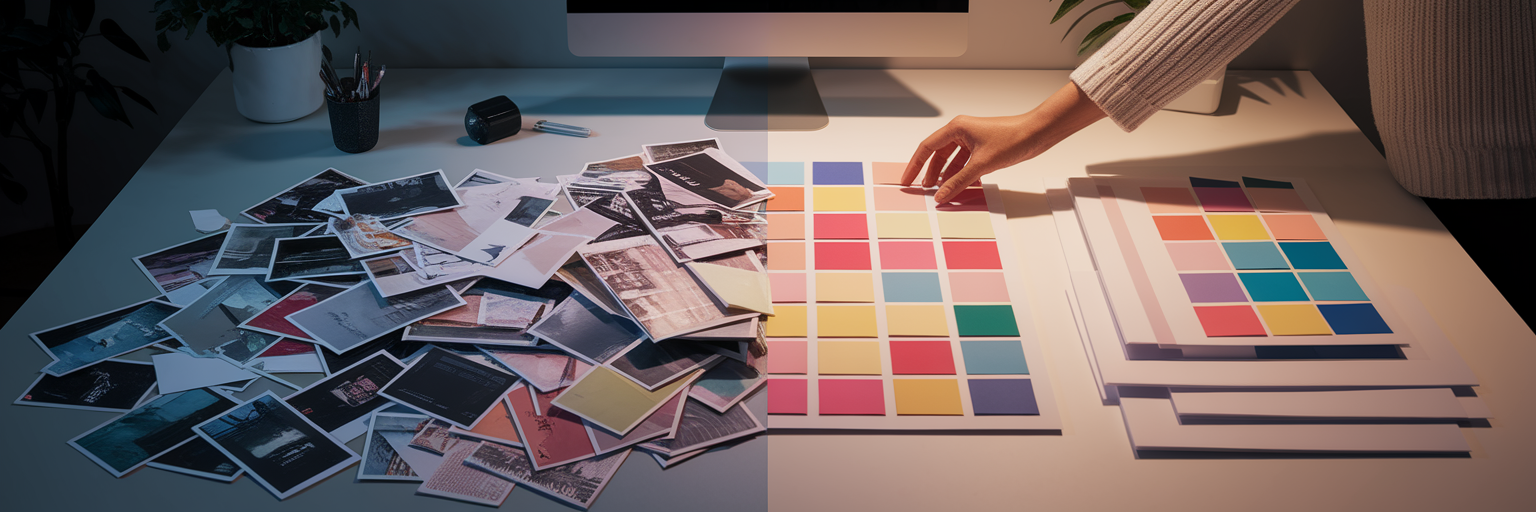The Freelancer's Dilemma: Too Many Ideas, Not Enough Time
We’ve all been there. The screen is a mosaic of 42 open tabs, your desktop is littered with ambiguously named screenshots, and that one perfect design reference is lost somewhere in a forgotten Pinterest board. All of this chaos unfolds while a project deadline is breathing down your neck. This scenario isn't just a quirky habit; it's a professional liability for any freelance developer.
This disorganized approach to inspiration actively consumes billable hours, creates decision fatigue, and stifles your creativity precisely when you need it most. Every minute spent hunting for a lost link is a minute not spent coding. This chaos is a direct threat to your efficiency and profitability.
But what if you could transform that mess into a powerful, time-saving asset? It’s possible to build a practical, repeatable system to organize design inspiration. With the right methods and tools, this process can become a seamless part of your creative workflow, not just another chore.
The Hidden Costs of a Scattered Inspiration Library
The frustration of a messy digital workspace goes beyond simple annoyance. It introduces hidden costs that quietly sabotage your projects. The most obvious is the time sink. Hunting for a specific reference across local folders, cloud drives, and various apps is a significant cognitive drain. This isn't just a few seconds here and there; it’s a cumulative loss of hours over the course of a project.
Then there's the critical issue of lost context. A saved link or screenshot is almost useless without the 'why.' Without notes, a brilliant idea you saved weeks ago becomes a meaningless digital artifact. This forces you to restart your research from scratch, retracing your steps and wasting valuable creative energy.
This disorganization also leads to inconsistent project outcomes. When you're under pressure, you're more likely to grab the most convenient piece of inspiration, not the most suitable one. This can compromise the final design and lead to work you're not proud of. A scattered inspiration system is a structural bottleneck in a professional freelance developer workflow, costing you time, money, and creative momentum.
The True Cost of a Disorganized vs. Organized Inspiration System
| Activity |
Cost of Disorganization (Per Project) |
Benefit of Organization |
| Finding a Specific Reference |
30-60 minutes of searching across platforms |
Seconds via tag-based search |
| Recalling Context |
Time wasted trying to remember 'why' something was saved |
Instant clarity from attached notes and tags |
| Onboarding a New Project |
Hours of redundant research for common patterns |
Pulling from a pre-vetted library of solutions |
| Maintaining Creative Flow |
Constant interruption and context-switching |
Uninterrupted focus on design and code |
This table illustrates the cumulative time and cognitive load saved by adopting a structured system. Estimates are based on common freelance project cycles where inspiration is gathered and referenced multiple times.
Building Your Single Source of Creative Truth

The solution begins with creating a centralized hub, a 'digital studio' for all your inspiration. This single source of truth stands in stark contrast to the inefficiency of having ideas fragmented across local drives, cloud services, and a dozen different apps. For creative professionals, especially front-end developers, a visual-first tool is non-negotiable. You need to see the design, not just a URL.
This is where a tool like Bookmarkify changes the game. Its features, like desktop and mobile previews, allow you to instantly analyze a layout's responsiveness without ever leaving your library. You can see how a design works on different screens at a glance, which is essential for modern web development.
Equally important is a frictionless capture process. The easier it is to save an idea, the richer your library will become. A one-click browser extension is essential for capturing inspiration in the moment without breaking your creative flow. The actionable step here is simple: choose one central tool and commit to it. Modern design inspiration tools are built for this exact purpose, unifying capture, organization, and retrieval into one seamless experience. You can explore more ideas and articles on our blog to enhance your creative process.
Organize for Action with a Smart Tagging System
Traditional folders have a fundamental limitation: an inspirational element can only exist in one place. But what about a design that is both 'e-commerce,' 'minimalist,' and features a unique 'checkout-flow'? A folder system forces you to choose, making retrieval a guessing game. Tagging, however, offers a flexible, multi-dimensional alternative.
Here is a practical starter framework for developers:
- By UI Component: #nav, #form, #pricing-table, #hero-section
- By Aesthetic: #brutalist, #dark-mode, #glassmorphism, #minimalist
- By Project Type: #saas, #portfolio, #e-commerce, #agency
Imagine you need inspiration for a SaaS pricing page with a minimalist feel. Instead of digging through folders, you simply filter by the #saas, #pricing-table, and #minimalist tags. In seconds, you see every relevant example you've ever saved. As creative professionals often note on platforms like LinkedIn, a streamlined system with clear conventions is foundational to beating chaos. This method is the core of effective visual bookmarking for developers. Platforms like Bookmarkify are built around this tagging and filtering logic, turning the hunt for hyper-specific inspiration into a quick, satisfying search.
Turn Your Library into an Actionable 'Second Brain'

Let's take this a step further. Your inspiration library shouldn't just be a digital storage unit; it should be an external, trusted system for processing and connecting ideas. This is the 'Second Brain' concept, and it’s perfect for a developer's needs. As author Tiago Forte explains, this system helps turn scattered ideas into actionable resources. A recent analysis by Dalton Craighead highlights why this is so powerful for web designers, freeing up mental bandwidth for coding and complex problem-solving.
You can implement this using the simple CODE method:
- Capture: Save anything that resonates without overthinking it. Use a tool with a quick-capture extension.
- Organize: Use the simple, action-oriented tagging system we just discussed.
- Distill: This is the most crucial step. When you save something, add a quick note on why. What did you like? The animation? The color palette? The copy? This adds the context that is so often lost.
- Express: Use your organized, distilled ideas to create new work with confidence.
You can also structure your library using the PARA method (Projects, Areas, Resources, Archives) with tags like #project-client-x for active work, #area-skilldev for personal growth, and #resource-animation for general reference. These frameworks aren't rigid rules but powerful mental models for creative project management, transforming a passive collection into a dynamic knowledge base that works for you.
From Library to Live Project: Closing the Workflow Loop
One of the biggest productivity killers is context-switching. Jumping between your inspiration app, your code editor, and a project management tool like Trello or Asana breaks your concentration and slows progress. The solution is to directly integrate your inspiration into your actionable tasks, closing the loop between idea and implementation.
This is where you learn how to build a moodboard quickly for a specific feature and link it directly within the corresponding task card. For example, imagine you're assigned a Trello card for 'Redesign User Dashboard.' In a tool like Bookmarkify, you can create a collection of 3-5 dashboard examples from your library, copy the unique shareable URL, and paste it directly into the Trello card's description. Now, your curated inspiration is just one click away from your task.
This simple action makes your inspiration library an active part of project execution, not a separate, forgotten archive. It saves time, maintains creative momentum, and ensures the best ideas make it into the final product. You can browse our curated collections to see just how powerful a well-organized visual library can be.
Stop Searching, Start Creating
Moving from a chaotic collection of links and screenshots to a streamlined, searchable system is more than just getting organized. For a freelance developer, it's a professional strategy. It allows you to deliver higher-quality work faster, which is the key to thriving on tight deadlines and building a successful career.
An organized inspiration system gives you confidence, clarity, and most importantly, more time to do what you love: build great things. Ready to trade the tab-juggling for a focused creative workflow? Start building your personal inspiration library today.
Try Bookmarkify for free and see how a visual-first system can change the way you work.












